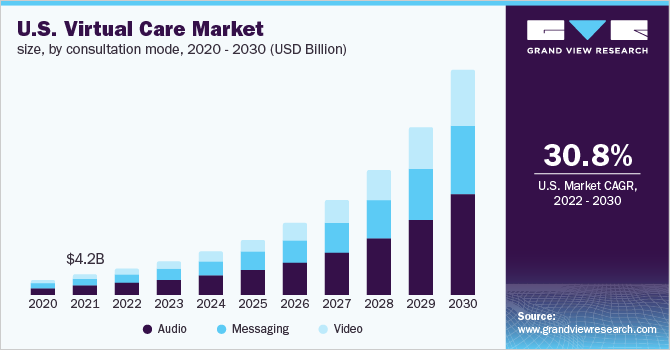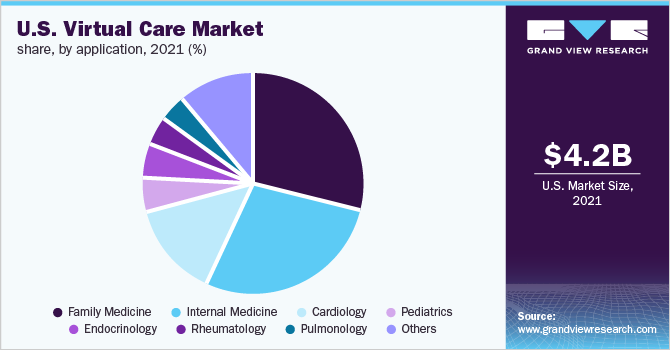- Home
- »
- Healthcare IT
- »
-
U.S. Virtual Care Market Size, Share, Growth Report, 2030GVR Report cover
![U.S. Virtual Care Market Size, Share & Trends Report]()
U.S. Virtual Care Market Size, Share & Trends Analysis Report By Application (Family Medicine, Internal Medicine, Cardiology), By Consultation Mode, And Segment Forecasts, 2022 - 2030
- Report ID: GVR-4-68039-943-7
- Number of Pages: 70
- Format: Electronic (PDF)
- Historical Range: 2017 - 2020
- Industry: Healthcare
Report Overview
The U.S. virtual care market size was valued at USD 4.2 billion in 2021 and is expected to expand at a compound annual growth rate (CAGR) of 30.75% from 2022 to 2030. Continuous development of advanced technologies, rising patient demand, and regulatory reforms are primary factors driving the market growth. According to the Association of American Medical Colleges, there will be a shortage of about 124,000 and 37,800 specialty and primary care physicians by 2034. The anticipated physician shortage in the U.S. is poised to surge the market growth in the coming years.

The U.S. government is making massive investments in digital health and boosting healthcare IT adoption, which is expected to stimulate market expansion. For instance, in February of 2021, the United States Department of Agriculture (USDA) spent USD 42 million on telemedicine infrastructure and remote learning to improve health outcomes and education. Through the Distance Learning and Telemedicine (DLT) program, the USDA financed 86 projects in rural regions to help individuals by offering healthcare education and grants to purchase telemedicine interactive telecommunications distance learning technology.
In recent years, digital healthcare has played a significant role in advancing health equity by providing timely treatment and clinical assessment, particularly to the most vulnerable population. To strengthen telehealth services and rural health in the U.S., the Biden-Harris Administration invested over USD 19 million through the Health Resources and Services Administration (HRSA) of the U.S. Department of Health and Human Services (HHS) in August of 2021.
COVID-19 U.S. Virtual Care Market Impact: ~100 % increase from 2019 to 2020
Pandemic Impact
Post-COVID-19 Outlook
The fast spread of the COVID-19 pandemic and the implementation of social distancing strategies propelled the expansion of the telehealth sector. High adoption of tools to virtually connect to doctors to resolve COVID-19-related queries and doubts positively impacted the market. As a result, the market nearly doubled in size between 2019 and 2020.
Post-pandemic, the use of online consultation and telemedicine is likely to remain higher than the pre-pandemic level. After realizing the potential of telehealth, the government is taking active steps to promote its adoption among hospitals and patients.
A substantial surge in demand for virtual healthcare was seen in 2020. For example, according to data published by the Centers for Disease Control and Prevention (CDC) in October 2020, the number of telehealth visits in March 2020 was 154% more than in March 2019.
Owing to the high demand, many start-up companies are emerging in the telemedicine industry. For example, in January 2022, Wheel Health, Inc. received USD 150 million in a Series C funding round led by Lightspeed Venture Partners and Tiger Global.
The COVID-19 pandemic has highlighted the significance of virtual healthcare services. Before the pandemic, the country made minimal use of telemedicine services. The industry has witnessed tremendous growth in response to the pandemic. Throughout the pandemic, telehealth has been viewed as an emergency tool. Hence, the government took proactive measures to support telemedicine utilization. The Centers for Medicare & Medicaid Services (CMS) provided a temporary extension of Medicare coverage and treatment done through telehealth during COVID-19. This allowed physicians to swiftly transition to offering health services virtually to their patients.
In February 2022, the HHS, through the HRSA, awarded nearly USD 55 million to 29 HRSA-funded health centers to improve the quality and accessibility of health care for underserved populations through remote patient monitoring, telehealth, and health information technology platforms, and digital patient tools. This investment is in addition to the roughly USD 7.3 billion that the American Rescue Plan spent on community health clinics in the previous year to help mitigate the impacts of the pandemic.
With the advent of technological advancements, the significance and utilization of virtual care in the healthcare industry continue to increase. Virtual care services such as video consultations, chats, and messaging are becoming more accessible for both patients and healthcare organizations. In addition, the rising incidence of illness and rapidly growing geriatric population are propelling the market growth.
The rising geriatric population is creating a burden on the current healthcare workforce. This coupled with a shortage of medical professionals is resulting in increased waiting time. As per a 2017 Survey of Physician Appointment Wait Times, a new patient has to wait an average of 24 days for a physician’s appointment in the U.S., up from 18.5 days in 2014. Online video or audio consultations helps in reducing the burden on the current workforce as well as provide easy access to the patients. Virtual care technologies offer the potential to improve patient-physician collaboration, patient access and health outcomes, patient satisfaction, and medical expenses. This is anticipated to boost the market growth.
Consultation Mode Insights
The audio segment accounted for the largest market share of 45.9% in 2021. Easy access and a higher preference for phone calls are factors driving the growth of the market. Moreover, many people reside on the side of the digital divide where access to technology and high-speed internet service is limited. More than 21 million Americans live in "digital deserts" according to the 2020 Broadband Deployment Report. Both rural and urban residents are affected by this issue.
The Pew Research Center discovered that less than 65% of rural individuals have a broadband internet connection in their homes, while more than 40% of low-income Americans do not have broadband connectivity in their homes. For these individuals, audio-only visits have proven to be a successful means of overcoming barriers to care such as mobility issues, lack of transportation, and lack of nearby providers. Moreover, audio-only consultations have expanded access to crucially needed behavioral health services.
The video segment is likely to witness remarkable growth over the forecast period. This growth is related to COVID-19. In April 2020, 43.5% of all Medicare primary care visits were conducted via telehealth; before the pandemic, this percentage was only 0.1%. While virtual care also encompasses phone and message consultations, the frequency of appointments conducted by video has risen dramatically. Video appointments via the Department of Veterans Affairs Video Connect System, for instance, increased to 120,000 per week in May of 2020 from 10,000 per week in February 2020.
Application Insights
In 2021, the family medicine segment dominated the U.S. virtual care market with a share of 29.4%. A high number of online consultations for acute and primary care is the main factor for the dominant share of the segment. The American Academy of Family Physicians (AAFP) recommends expanding the use of telemedicine as an efficient and appropriate means of enhancing health when handled by adequate standards of care.
During the pandemic, more than 80% of family physicians began delivering online appointments, according to a recent AAFP poll. In addition, almost 70% of respondents would prefer to deliver health services virtually in the future. Thus, increasing adoption of virtual care by family physicians is expected to fuel the growth of the segment.

Moreover, the internal medicine segment held a significant portion of the market in 2021. According to a survey conducted by the American College of Physicians (ACP), internal medicine physicians and subspecialists would like to use virtual care technologies more than they do currently. The survey revealed that more than half of the respondents are interested in learning more about connected care technologies.
Also, one-third of telemedicine users use e-consults to collaborate with specialists at least once a week. The technology is used by around one-quarter of telehealth users to communicate with patients and manage care outside the clinic. Nearly 18% of telehealth/telemedicine users conduct video visits with patients, and 19% use the platform at least once a week. The aforementioned factors are expected to drive the segment growth.
Key Companies & Market Share Insights
The market is highly fragmented with the presence of large and small players. Investment in the latest technologies, acquisitions, collaborations, and expanding services to multiple specialties are some of the strategies adopted by the market players to expand in the market. Teladoc Health Inc., American Well Corporation, and MDLIVE account for the leading players in the market.
In January 2020, for instance, Teladoc Health Inc. entered into a deal to purchase InTouch Health to expand its telemedicine offerings and expand its reach across hospitals and healthcare facilities. In addition, American Well Corporation raised USD 194 million in May 2020 to address the soaring demand for remote healthcare services. Some prominent players in the U.S. virtual care market include:
-
Teladoc Health, Inc.
-
American Well Corporation
-
MDLIVE
-
Doctor on Demand, Inc.
-
Virtuwell
-
CVS health
-
MeMD
-
HealthTap, Inc.
-
iCliniq
-
Sesame, Inc.
U.S. Virtual Care Market Report Scope
Report Attribute
Details
Market size value in 2022
USD 5.4 billion
Revenue forecast in 2030
USD 46.3 billion
Growth Rate
CAGR of 30.75% from 2022 to 2030
Base year for estimation
2021
Historical data
2017 - 2020
Forecast period
2022 - 2030
Quantitative units
Revenue in USD billion and CAGR from 2022 to 2030
Report coverage
Revenue forecast, company ranking, competitive landscape, growth factors, and trends
Segments covered
Application, consultation mode
Country scope
U.S.
Key companies profiled
Teladoc Health, Inc.; American Well Corporation; MDLIVE; Doctor on Demand, Inc.; Virtuwell; CVS health; MeMD; HealthTap, Inc.; iCliniq; Sesame, Inc.
Customization scope
Free report customization (equivalent up to 8 analysts working days) with purchase. Addition or alteration to country, regional & segment scope.
Pricing and purchase options
Avail customized purchase options to meet your exact research needs. Explore purchase options
Segments Covered in the ReportThis report forecasts revenue growth at the country level and provides an analysis of the latest industry trends and opportunities in each of the sub-segments from 2017 to 2030. For this study, Grand View Research has segmented the U.S. virtual care market report based on application and consultation mode:
-
Application Outlook (Revenue, USD Million, 2017 - 2030)
-
Family Medicine
-
Internal Medicine
-
Cardiology
-
Pediatrics
-
Endocrinology
-
Rheumatology
-
Pulmonology
-
Others
-
-
Consultation Mode Outlook (Revenue, USD Million, 2017 - 2030)
-
Video
-
Audio
-
Messaging
-
Frequently Asked Questions About This Report
b. The U.S. virtual care market size was estimated at USD 4.2 billion in 2021 and is expected to reach USD 5.4 billion in 2022.
b. The U.S. virtual care market is expected to grow at a compound annual growth rate of 30.75% from 2022 to 2030 to reach USD 46.3 billion by 2030.
b. The audio segment dominated the U.S. virtual care market with a share of 45.9% in 2021. In the United States, nearly 50 % of the 85.5 million virtual interactions covered by the Kaiser Permanente System health plan were conducted via phone.
b. Some key players operating in the U.S. virtual care market include Teladoc Health, Inc., American Well Corporation, MDLIVE, Doctor on Demand, Inc., Virtuwell, CVS Health, MeMD, HealthTap, Inc., iCliniq, and Sesame, Inc. .
b. Key factors that are driving the U.S. virtual care market growth include strong government support, shift towards convenient care, and rising prevalence of chronic diseases.
Share this report with your colleague or friend.
![gvr icn]()
NEED A CUSTOM REPORT?
We can customize every report - free of charge - including purchasing stand-alone sections or country-level reports, as well as offer affordable discounts for start-ups & universities. Contact us now
![Certified Icon]()
We are GDPR and CCPA compliant! Your transaction & personal information is safe and secure. For more details, please read our privacy policy.
We are committed towards customer satisfaction, and quality service.
"The quality of research they have done for us has been excellent."





